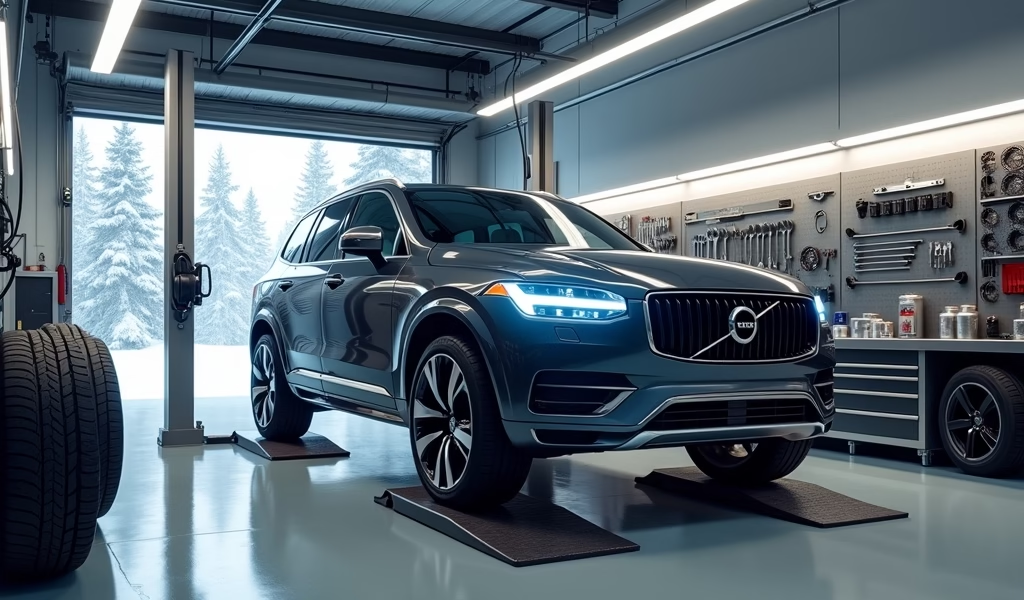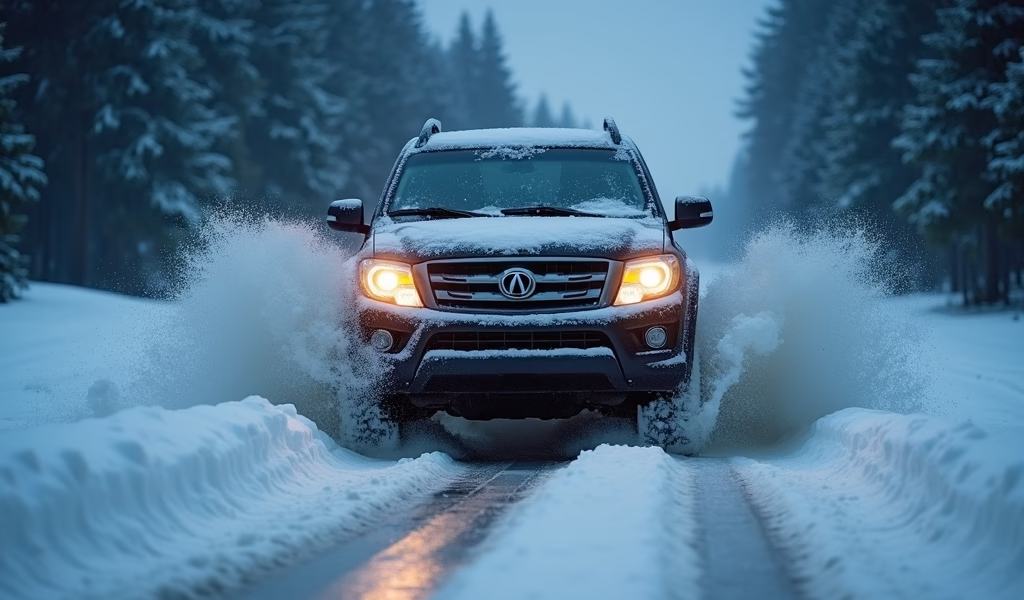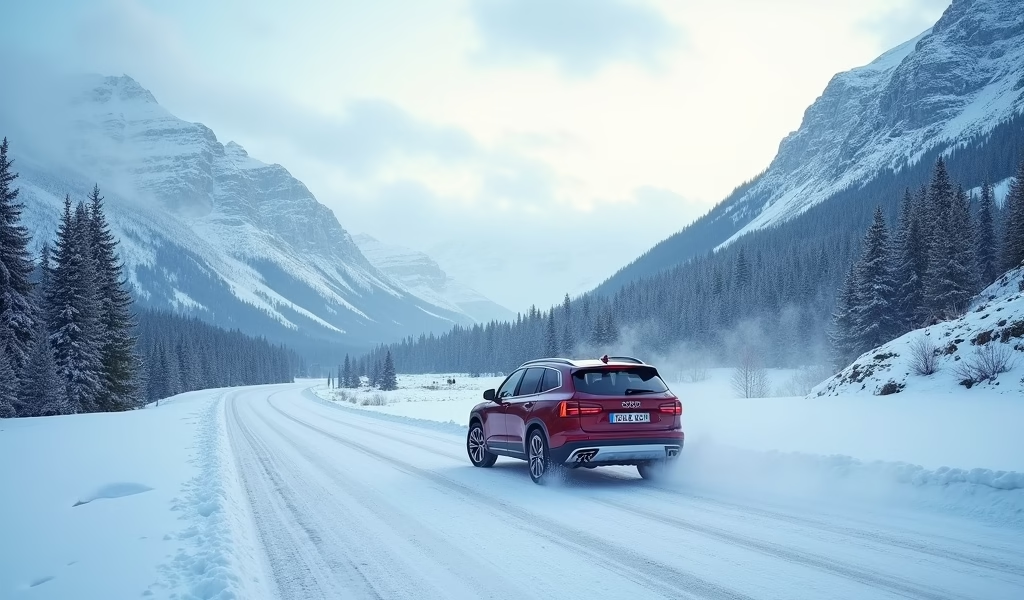Overview
This article details essential winter maintenance for AWD vehicles across five critical areas: tire care, AWD system inspection, battery preparation, brake system maintenance, and undercarriage protection against corrosion. While AWD provides superior traction in snow, its effectiveness depends on proper maintenance, particularly winter tires, as the system helps with acceleration but offers no advantage when braking on slippery surfaces.
Table of Contents
- AWD in Snow: The Truth About Performance
- Tire Maintenance: Your First Line of Defense
- AWD System Inspection and Maintenance
- Battery and Electrical System Preparation
- Brake System Maintenance: The Reality Check
- Undercarriage Protection: Fighting Winter Corrosion
- Special Considerations for Hybrid AWD Vehicles
- Conclusion: Maximizing Your AWD in Winter
- Frequently Asked Questions
AWD in Snow: The Truth About Performance
When winter rolls in with its blanket of snow, all-wheel drive systems truly shine on slippery roads. As a mechanic who’s helped countless drivers prepare for winter, I can tell you that AWD provides remarkable traction by distributing power to all four wheels simultaneously. This gives you better stability and control when accelerating on snow-covered roads.
But here’s the thing – even the best AWD system needs proper maintenance to perform at its peak during winter. I’ve seen too many drivers come in with AWD vehicles struggling in snow simply because they neglected basic maintenance. It’s like having a top-tier snow blower with dull blades – the potential is there, but the performance isn’t.
What makes AWD especially effective in snow is its ability to sense wheel slip and redirect power to wheels with better traction. This happens in milliseconds, often before you even realize you’re losing grip. But this complex system relies on several components working in harmony, and winter’s harsh conditions put extra stress on each one.
Let’s look at the five essential maintenance areas that will help your AWD vehicle dance through snow instead of struggle through it. Each tip comes from years in the garage seeing what works and what doesn’t when the temperatures drop and the snow piles up.
Tire Maintenance: Your First Line of Defense

Your AWD system might be sophisticated, but it’s only as effective as the four rubber patches connecting your vehicle to the road. I’ve seen many drivers put too much faith in their AWD system while neglecting their tires – that’s a recipe for disappointment when snow falls.
Winter Tires vs. All-Season: The Real Difference
Winter tires are designed with special rubber compounds that stay pliable in cold temperatures. All-season tires, by comparison, typically harden when temperatures drop below 45°F, significantly reducing traction. According to studies from Tire Rack, winter tires can improve stopping distances by up to 30% compared to all-seasons in snowy conditions.
The aggressive tread patterns on winter tires are designed to channel snow and slush while providing biting edges that grip snow. Think of them as specialized tools – you wouldn’t use a butter knife to cut down a tree, right?
Tire Pressure in Winter
Cold air causes tire pressure to drop – approximately 1 PSI for every 10°F decrease in temperature. Low tire pressure reduces traction and can cause uneven wear, hampering your AWD system’s effectiveness. Check your tire pressure at least twice monthly during winter, ideally when tires are cold.
The correct pressure isn’t always the maximum listed on the tire sidewall. Check your driver’s door jamb or owner’s manual for the manufacturer’s recommended pressure specific to your vehicle.
Rotation and Tread Depth
AWD systems can sometimes mask uneven tire wear until it becomes severe. I recommend rotating tires every 5,000-7,000 miles to ensure even wear and extend their life.
For tread depth, the legal minimum is 2/32 inch, but for winter driving, you should have at least 6/32 inch. A simple way to check: insert a quarter into the tread with Washington’s head facing down. If the tread reaches Washington’s forehead, you have about 4/32 inch remaining – sufficient for mild conditions but consider replacement before heavy snow season.
AWD System Inspection and Maintenance
The heart of your vehicle’s winter performance lies in its AWD system – a complex arrangement of differentials, transfer cases, and electronic controls that work together to deliver power where it’s needed most.
Differential and Transfer Case Fluids
These specialized fluids lubricate and cool critical components in your AWD system. As they age, their viscosity changes, making them less effective, especially in extreme temperatures. Most manufacturers recommend checking these fluids every 30,000 miles, but I suggest an inspection before each winter season if you regularly drive in snow.
The color and smell of these fluids tell an experienced mechanic a lot about your AWD system’s health. Fresh fluid has a clear, amber color and a mild odor. If it’s dark, has a burnt smell, or contains metal particles, your system is telling you something’s wrong.
Listen for Warning Signs
Your AWD system will often tell you when it’s unhappy. Strange noises during cornering, vibrations during acceleration, or difficulty turning can all indicate AWD issues. Don’t ignore these symptoms – they rarely resolve themselves and usually worsen with time, especially under the added stress of winter driving.
Pay attention to your dashboard too. Modern AWD systems have sensors monitoring everything from fluid temperature to torque distribution. If an AWD warning light illuminates, don’t wait until you’re stuck in a snowbank to address it.
Hubs and CV Joints
These components transfer power from your drivetrain to your wheels. Snow, ice, and salt can accelerate wear on their protective boots and seals. During pre-winter maintenance, have these inspected for tears or cracks that could allow moisture and contaminants to enter.
AWD systems have advantages over FWD in snow because they can instantly redistribute power when slippage occurs – but only if all components are in good working order.
Battery and Electrical System Preparation
Winter’s cold temperatures can reduce battery capacity by up to 50%, making a marginal battery suddenly insufficient for starting. Nothing’s worse than being stranded on a freezing morning because your battery couldn’t deliver when needed.
Battery Health Check
Have your battery load-tested before winter arrives. This test measures its ability to hold voltage under stress – exactly what happens when you start your car in cold weather. Most batteries last 3-5 years, so if yours is approaching this age, consider proactive replacement before winter.
Keep battery terminals clean and tight. Corrosion restricts electrical flow, reducing starting power when you need it most. A simple mixture of baking soda and water works wonders for cleaning terminals. After cleaning, applying a small amount of petroleum jelly can help prevent future corrosion.
Lighting and Visibility Systems
Winter’s shorter days mean you’ll rely more heavily on your lights. Check all exterior lights – headlights, taillights, turn signals, and brake lights – replacing any that are dim or non-functional. Don’t forget to verify that your headlights are properly aimed; misaligned headlights reduce visibility and can blind oncoming drivers.
Ensure your wipers clear the windshield completely without streaking, and test both front and rear defrosters to confirm they quickly clear condensation and ice. These systems aren’t just conveniences in winter – they’re safety equipment that prevents accidents.
Charging System
Your alternator keeps your battery charged and powers electrical systems once the engine is running. Have it tested along with your battery, especially if you’ve noticed dimming headlights or electrical accessories that seem sluggish.
Even the best AWD system can’t help if electrical problems prevent your vehicle from starting or running properly in winter conditions.
Brake System Maintenance: The Reality Check
Here’s a critical fact too many AWD owners overlook: while AWD helps with acceleration and stability, it offers absolutely no advantage when braking on snow or ice. In fact, AWD vehicles are typically heavier than their two-wheel-drive counterparts, potentially requiring longer stopping distances.
I’ve seen too many confident AWD drivers slide through intersections because they overestimated their vehicle’s ability to stop on slick surfaces. AWD helps you go – it doesn’t help you stop.
Brake Fluid
Brake fluid absorbs moisture over time, which can freeze in cold temperatures and compromise braking performance. Most manufacturers recommend changing brake fluid every two years regardless of mileage.
The color of your brake fluid provides clues about its condition. Fresh fluid is clear to amber; dark brown fluid indicates contamination and should be changed immediately.
Brake Components
Have your brake pads, rotors, and calipers inspected before winter arrives. Worn pads or warped rotors reduce stopping power precisely when you need it most. For winter driving, I recommend having at least 50% of your brake pad material remaining.
Listen for squealing, grinding, or pulsating sensations when braking – these are all warning signs that shouldn’t be ignored. According to the National Highway Traffic Safety Administration, brake issues contribute to approximately 22% of accidents where vehicle factors are cited.
ABS System
Your anti-lock braking system is especially valuable on slippery surfaces, preventing wheel lockup and allowing you to maintain steering control while braking. If your ABS warning light is illuminated, address this immediately – don’t wait until you need this critical safety system.
Remember that proper braking technique on snow involves gentle, progressive pressure rather than sudden applications. Give yourself three times the normal following distance and begin slowing earlier than you would on dry pavement.
Undercarriage Protection: Fighting Winter Corrosion

Road salt and winter chemicals are brutally effective at melting ice but equally effective at corroding your vehicle’s undercarriage. This hidden damage can compromise structural integrity and AWD components over time.
Regular Undercarriage Washing
One of the most effective yet overlooked winter maintenance tasks is regularly washing your vehicle’s undercarriage. You can do this yourself at most self-service car washes that offer undercarriage spray options. During winter months, try to wash the underside of your vehicle at least twice monthly, focusing particularly on wheel wells and exposed chassis components.
The best time for this is during winter thaws when temperatures rise above freezing. This allows you to rinse away accumulated salt and chemicals before they can cause significant corrosion.
Protective Coatings
Consider applying an undercarriage protectant before winter begins. These products create a barrier between metal components and corrosive elements. While professional application provides the most comprehensive coverage, DIY spray products can offer reasonable protection for the budget-conscious.
Pay particular attention to suspension components, brake lines, and fuel lines – all critical systems that can be compromised by corrosion. Even small rust spots should be addressed promptly, as winter conditions accelerate corrosion dramatically.
Inspection Points
During undercarriage washes, take a moment to inspect for developing issues. Look for rust formation, damaged protective shields, or loose components. Early intervention prevents minor problems from becoming major repairs.
Check rubber bushings and mounts as well – these can crack in cold temperatures and allow unwanted movement that stresses other components. Keeping these in good condition helps maintain your AWD system’s alignment and effectiveness.
Special Considerations for Hybrid AWD Vehicles
If you drive a hybrid AWD vehicle, you benefit from unique technology that requires specific maintenance considerations, especially in winter conditions.
Hybrid AWD System Types
Many hybrid AWD systems use electric motors to power the rear wheels rather than a traditional mechanical connection. This creates an efficient on-demand system that activates only when needed. While this design reduces fuel consumption, it requires proper battery maintenance to ensure consistent performance in winter.
Some systems, like Toyota’s Electronic On-Demand AWD, rely entirely on the hybrid battery for rear-wheel power. If your hybrid battery isn’t performing optimally, your AWD capability could be compromised without warning.
Battery Performance in Cold
Cold weather can significantly reduce hybrid battery performance. When possible, park in a garage or sheltered area to keep battery temperature higher. Allow your hybrid AWD vehicle a brief warm-up period before demanding maximum performance in snow.
Keep your hybrid battery properly charged by regularly driving your vehicle rather than leaving it parked for extended periods. Short trips without allowing the battery to fully warm up and charge can reduce overall system performance, including your AWD capabilities.
Regenerative Braking Adjustments
Many hybrids use regenerative braking systems that can feel different on slippery surfaces. Familiarize yourself with how your vehicle’s braking feels in various winter conditions and remember that physical brakes still require regular maintenance despite the regenerative system.
Some hybrid vehicles allow you to adjust regenerative braking strength. In snowy conditions, reducing regenerative braking intensity can provide smoother deceleration and better stability. Consult your owner’s manual for specific guidance on winter settings for your model.
Despite their unique design, hybrid AWD systems still benefit from the same tire, brake, and undercarriage maintenance as conventional AWD vehicles. The electrical components simply add another layer of consideration for winter preparation.
Conclusion: Maximizing Your AWD in Winter
AWD technology is remarkable in snow, but it’s only as effective as the maintenance behind it. By focusing on these five critical areas – tires, AWD system components, electrical systems, brakes, and undercarriage protection – you’re giving your vehicle the best chance to perform when winter conditions are at their worst.
Remember that while many maintenance tasks can be handled yourself, some aspects of AWD maintenance require professional expertise and specialized equipment. Don’t hesitate to consult with a qualified technician if you’re uncertain about any aspect of your vehicle’s winter preparation.
The DIY approach works well for regular undercarriage washing, tire pressure checks, and basic inspections. However, fluid analyses, electronic system diagnostics, and comprehensive AWD system evaluations typically require professional attention to ensure nothing is overlooked.
Winter driving demands more from your vehicle than any other season. By investing time in preparation now, you’ll enjoy confident driving when others are struggling with the challenges of snow and ice. Your AWD system is an impressive tool for winter mobility – these maintenance practices help ensure it delivers its full potential when you need it most.
If you have questions about preparing your specific AWD model for winter, or if you’d prefer to have professionals handle your winter maintenance needs, don’t hesitate to reach out to us. Our team specializes in AWD system maintenance and winter preparation for all types of vehicles.
Schedule your comprehensive winter maintenance check today, and drive with confidence through whatever winter brings your way.
Frequently Asked Questions
Does AWD help with stopping in snow?
No, AWD only helps with traction during acceleration and cornering. Stopping distance on snow depends entirely on your tires and braking system, not your drive type.
Are winter tires really necessary if I have AWD?
Yes, winter tires are highly recommended even with AWD. Studies show AWD with winter tires provides up to 42% better traction than AWD with all-season tires in snow.
How often should AWD fluids be changed for winter driving?
For vehicles regularly driven in snow, inspect AWD fluids annually before winter begins. Most manufacturers recommend changing these fluids every 30,000-60,000 miles depending on driving conditions.
Can I damage my AWD system by using it in deep snow?
Prolonged wheel spinning in deep snow can overheat AWD components. If your vehicle becomes stuck, alternate between gentle acceleration and rest rather than continuous high-throttle attempts.
Is AWD worth the extra cost for occasional winter driving?
For occasional winter driving, proper winter tires on a front-wheel-drive vehicle might be more cost-effective. AWD shows its greatest value in areas with frequent snow or for drivers who cannot avoid traveling during severe winter conditions.


Pingback: Can You Drive in Snow? Top Car Care Tips - knowsyourcar.com